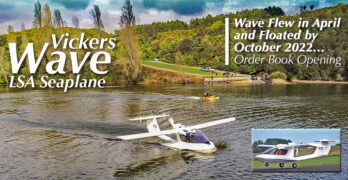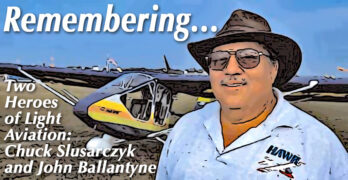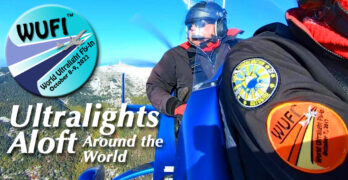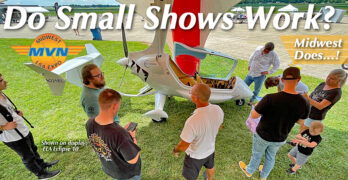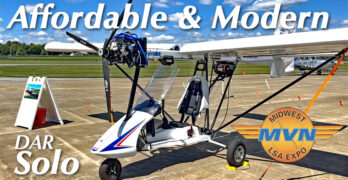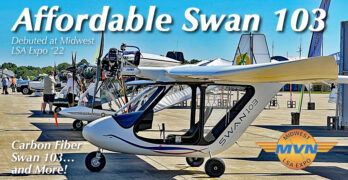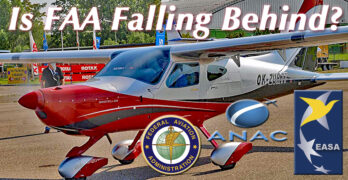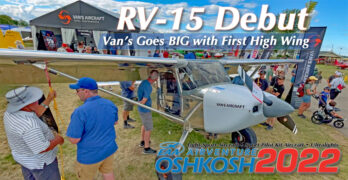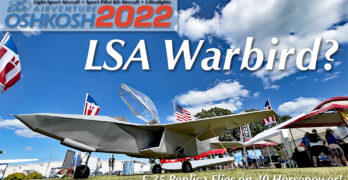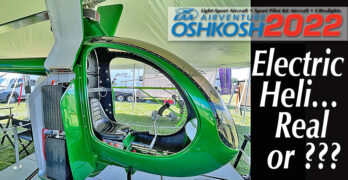One of the longest-awaited Light-Sport development projects has been Vickers Aircraft’s Wave, a sophisticated amphibious LSA seaplane. Following the media-drenched Icon A5, Vickers in New Zealand took their time to get Wave right.
Remember, seasons are reversed in the Southern Hemisphere. New Zealand is now emerging from winter (during our summer) and is beginning its warmer climate. The summer months in New Zealand are December, January, and February so the weather is getting nice down under.
One of the explanations for the longer development cycle was that Vickers Aircraft was making a massive effort to reduce part count to aid manufacturing and reduce cost. Wave first announced $189,000 but this will likely come in substantially higher …along with everything else you are buying these days. Similarly, A5 arrived on the market more than ten years ago at $139,000 but has risen to beyond $350,000. Some of that could be due to manufacturing challenges, exactly the reason Paul Vickers insisted on taking the time needed to control expenses.
Search Results for : Flight Design
Not finding exactly what you expected? Try our advanced search option.
Select a manufacturer to go straight to all our content about that manufacturer.
Select an aircraft model to go straight to all our content about that model.
Honoring Two Important Light Aviation Pioneers — Chuck Slusarczyk and John Ballantyne
UPDATE Note (10/15/22): I urge all readers to take special note of two comments below that greatly add to the respect I intended to show John Ballantyne and Chuck Slusarczyk. I hope you’ll take the time to read both. —DJ
A Tribute… to Two Heroes
of Recreational Aviation
CHUCK SLUSARCZYK — On September 29, 2022, the sport aviation industry lost one of its best-known innovators, Chuck Slusarczyk (“Slew-zar-chick”). He was 81 years old.
A pioneer in both hang glider and ultralight aircraft industries — founder of Chuck’s Glider Supplies which became known as CGS Aviation — Chuck had worked at NASA Lewis in Cleveland, Ohio.
After striking out on his own, he designed numerous hang gliders and, later, the award-winning CGS Hawk.
Chuck was an inaugural inductee into the EAA Ultralight Hall of Fame. His aircraft are on display in three aviation museums including at EAA and Sun ‘n Fun.
WUFI… A Different Sort of Aviation Event — On October 8 & 9, Thousands of Ultralight Enthusiasts Take to the Sky
While those of us in Florida hangared our aircraft and hunkered down for Hurricane Ian, elsewhere in the world, many pilots were preparing their airplanes and gearing up for one of the biggest aviation events you’ll never see.
This weekend perhaps thousands of light, sport, recreational aircraft owners will take their ultralights (or other light aircraft) into the sky for a kind of “virtual” airshow, except it isn’t computer simulators. It is only virtual in the sense that nearly all aviators will help create an “airshow” without seeing another aircraft. “Analog” might be a better term than virtual.
The innovative concept makes WUFI (on Facebook) about as different from Oshkosh as you can get yet it generates its own high level of enthusiasm.
Note to recreational pilots: YOU can join the action and be part of the world’s largest airshow …largest by virtue of it being spread all over the planet on one weekend!
Midwest LSA Expo Wrap-Up — Metrics Reveal the Strength of These “Sector-Specific Shows”
Sun ‘n Fun does it. EAA AirVenture Oshkosh did it. Why not the smaller, sector-specific shows? Indeed, why not? I refer to reporting of show statistics when the event concludes. In modern vernacular, these are “metrics.”
The likable and longtime manager of the Mt. Vernon, Illinois municipal airport, Chris Collins, has been forwarding some “metrics” from this year’s 14th annual event. Whatever you choose to call the numbers from an event, they provide useful information on how the show performed.
One comment measurement is the number of airplanes sold or the quantity of interested pilots who expressed real interest. Trying to get hard information is like nailing Jello to a wall. We get tidbits and potential but hard facts are hard to assemble. A genuinely interested person ready to make a deal could experience problems right after the event. Some (understandably) need to check with their spouse; that sometimes alters a decision.
Midwest LSA Expo; Day 2 — DAR’s Solo Is An Affordable and Modern Part 103 Ultralight
Some kind of remarkable thing happened here in Mt. Vernon, Illinois where the Midwest LSA Expo is taking place. Out of the 30 or 40 airplanes on display, no less than three of them are what I’ll call “next generation” Part 103 ultralight entries.
It would be amazing to see three new ones of any sort, but all three of these are modern. They all use contemporary materials yet they have all been shown to qualify for FAA’s simplest regulation.
The three are Chip Erwin’s Merlin Lite, the AVI Swan I wrote about yesterday, and today’s subject: AeroplanesDAR’s Solo. All three are impressive and all three break away from the common Part 103 ultralight using “tube and gusset” construction
Two years ago I reported on the Merlin Lite and the pace of its innovative development has quickened. Chip’s popular entry will soon enter into a new production agreement so the airplanes will be assembled here in the USA by a longtime reliable expert.
Midwest LSA Expo; Day 1 — The Sleek, Affordable, Foldable, Trailerable Swan 103
While I have been familiar with AVI’s Swan for several years, having earlier seen it at the German Aero show, this was a first appearance for Swan in the United States. What’s brand new is the Swan 103 model made specifically for FAR Part 103. The new model made its American debut at the Midwest LSA Expo. [September 9 UPDATE: Tom Bartlett’s contact info has been added; see “Article Links” toward the end of the article. —DJ]
This is the 14th running of the popular show in Mt. Vernon, Illinois. It’s what I call an intimate, sector-specific show. By that I mean it is all the sort of aircraft I cover on this website… Light-Sport Aircraft, Sport Pilot-eligible kit aircraft, and ultralight aircraft.
Thursday is regarded as one of the slower days of the three-day event — some vendors only attend on Friday and Saturday. Yet at least two airplanes and maybe three or four were sold on opening day.
While FAA Reworks Mosaic, Other Nations Are Moving Ahead — Is USA Falling Behind?
Capitalism and competition are one thing. Government policies and actions are quite another. You already know this.
Sometimes, however, these two seemingly-opposite concepts aren’t so different. What does this have to do with Light-Sport Aircraft?
American pilots, like aviators in other countries, must obey regulations in the nation where they operate their airplanes. Yet the same requirement is not necessarily true for those who produce the airplanes we enjoy. Producers, it turns out, have choices.
Under an arrangement called reciprocity, manufacturers in certain nations (Note 1; see at bottom) can meet their local regulations and FAA will then accept such aircraft without them going through the American certification system. What results is a form of competition between government regulatory agencies.
European builders may be early users and beneficiaries but American companies could use reciprocity as well.
Readers may remember that when Cessna was still promoting their ill-fated Skycatcher SLSA, they considered pursuing 1990’s-era Primary Category.
RV-15 High Wing Debuts to Crowds at Oshkosh 2022; Does Van’s Know Something You Don’t?
Is it an LSA or is it not an LSA? Is that the question?
When Van’s broke the news that their latest RV-15 model was a high wing, plenty of pilots snapped to attention. This company has produced one winner after another; here is their latest. Its bare aluminum glistened in bright sunlight and drew crowds through every day of Oshkosh 2022.
Will the model join the long line of distinguished RV models as a kit-built aircraft or could the company’s first-ever high wing signify something else. After all, Van’s did bring in-house full manufacturing of their successful RV-12 LSA.
Does Van’s know something you don’t know? Oh, very probably they know far more than you know but the question digs at who knows what FAA is doing. Here’s one company that may have a better handle on that than most others.
Van’s president Rian Johnson is the head of the ASTM F37 committee that is working closely with the FAA to formulate standards that will be used when the new breed of LSA come on the market, which I now predict will happen in 2025.
Oshkosh 2022 – Day 3… Build Your Own LSA-Sized Warbird, a Stunning Eye Catcher
EAA has reported that the Warbird displays (ground and flight) are the single biggest draw at EAA AirVenture Oshkosh. Whatever the numbers, almost all attendees enjoy seeing World War II warbirds still flying, often in large formations. They make quite the inspiring sight.
Another point of wide agreement among pilots is that perhaps the P-51 Mustang is the most popular airplane ever …if they are baby boomers.
Archon developers and sellers Dave Hertner and Bill Canino reported that younger pilots aren’t necessarily enamored of the WWII fighters. Those aircraft flew more than half a century before they were born.
What young military aircraft enthusiasts recognize are machines like Lockheed’s F-35. Common on late-generation fighters, F-35 is all sharp edges and angled facets. It’s quite — to use a word of another generation — gnarly and vicious looking.
You can’t even afford the fuel bill to fly one of Lockheed’s big bad boys.
Oshkosh 2022 – Day 2… Electric Helicopter from Composite FX is Lean, Green Machine
A year ago at Oshkosh, I became intrigued by the way Composite FX had developed the older Mosquito into their XE line; multiple models running from a legitimate Part 103 helicopter, their XEL model, to the turbine XET model. The company builds these handsome aircraft in Trenton, Florida after acquiring the design from Canadian John Uptigrove (see image of his original).
Vertical takeoff has a special appeal, even to those of us with little or no rotary experience. Setting aside the skills to fly such machines, the cost of a helicopter is usually so high that many don’t even consider it. Maybe they didn’t look far enough.
Composite FX and their $60,000 ready-to-fly XEL model (kit for $47,000) completely changes that thought experiment. Not only does this handsome aircraft perform impressively in experienced hands but many can afford it.
Yet this article is not about the product line the manufacturer is presently delivering.
- « Previous Page
- 1
- …
- 52
- 53
- 54
- 55
- 56
- …
- 147
- Next Page »


